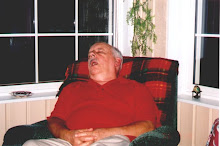The Compact Fluorescent Light (CFL)
I think we are being sold a bill of goods on the CFLs. True, they use less power for the same amount of light, but that's not the whole story, especially in a country like Canada where the heating season lasts nine months.
The traditional incandescent bulb, like a politician, emits more heat than light. (Sorry, I just had to get that in.) A 100W bulb gives off 90W of heat, 10W of light. That 90W contributes to heating the house during the heating season, thus lessening the load on the oil furnace or the electric heaters. The added electrical cost is roughly balanced by the lower oil cost. So, in effect, you can leave the lights on all the time and not suffer financial loss. This is not true in summer, of course, but there is less need for artificial light due to long daylight. I suppose you could remove the incandescent in June and screw in the CFL, then reverse the process in September, but who's going to do that? So, that's reason #1 for sticking with the traditional.
The CFL is apparently not as long lasting as claimed. According to Macleans Magazine, clerks at Home Depot report that CFLs are coming back "in droves" because they fail. Longevity seems to depend on whether the bulb stands up, as in a table lamp, or faces down as in a ceiling light. It is reported that the "down" ones cook themselves. And if they are turned on and off frequently, they won't last very long, according to Consumer Reports, who also advise that if one breaks, extreme measures are required in clean-up. Open all the windows, leave the room for 15 minutes, sweep, not vacuum, the shards, seal them in a plastic bag, which you then place in another plastic bag before throwing in the trash. Use rubber gloves. If the shards fall on a rug, use sticky tape for pick-up, then do the plastic bag thing and vacuum. Then the vacuum has to be cleaned, bag removed and placed in - you guessed it - double plastic bags. Wash hands. Are we getting a little ridiculous here? CFLs are branded dangerous waste in Europe and banned from landfills.
The RF harmonics and the infra-red light emitted by these bulbs can interfere with TV remotes, cell phones, laptops and even your health as some experts suggest.
Now, if you still want to go the CFL route, your incandescents end up in landfill, just when parts of this country are running out of landfill sites. Also note that most CFLs come from China, meaning that ships and planes use a lot of fossil fuel to get them here.
They reportedly don't work well in the cold, so that takes care of porch lights, although there are costly special ones for the purpose. And the normal ones cost about six times more. You need a special bulb if you have a dimmer switch. The list goes on.
So enough of this environmental chic. Let's get real.
The traditional incandescent bulb, like a politician, emits more heat than light. (Sorry, I just had to get that in.) A 100W bulb gives off 90W of heat, 10W of light. That 90W contributes to heating the house during the heating season, thus lessening the load on the oil furnace or the electric heaters. The added electrical cost is roughly balanced by the lower oil cost. So, in effect, you can leave the lights on all the time and not suffer financial loss. This is not true in summer, of course, but there is less need for artificial light due to long daylight. I suppose you could remove the incandescent in June and screw in the CFL, then reverse the process in September, but who's going to do that? So, that's reason #1 for sticking with the traditional.
The CFL is apparently not as long lasting as claimed. According to Macleans Magazine, clerks at Home Depot report that CFLs are coming back "in droves" because they fail. Longevity seems to depend on whether the bulb stands up, as in a table lamp, or faces down as in a ceiling light. It is reported that the "down" ones cook themselves. And if they are turned on and off frequently, they won't last very long, according to Consumer Reports, who also advise that if one breaks, extreme measures are required in clean-up. Open all the windows, leave the room for 15 minutes, sweep, not vacuum, the shards, seal them in a plastic bag, which you then place in another plastic bag before throwing in the trash. Use rubber gloves. If the shards fall on a rug, use sticky tape for pick-up, then do the plastic bag thing and vacuum. Then the vacuum has to be cleaned, bag removed and placed in - you guessed it - double plastic bags. Wash hands. Are we getting a little ridiculous here? CFLs are branded dangerous waste in Europe and banned from landfills.
The RF harmonics and the infra-red light emitted by these bulbs can interfere with TV remotes, cell phones, laptops and even your health as some experts suggest.
Now, if you still want to go the CFL route, your incandescents end up in landfill, just when parts of this country are running out of landfill sites. Also note that most CFLs come from China, meaning that ships and planes use a lot of fossil fuel to get them here.
They reportedly don't work well in the cold, so that takes care of porch lights, although there are costly special ones for the purpose. And the normal ones cost about six times more. You need a special bulb if you have a dimmer switch. The list goes on.
So enough of this environmental chic. Let's get real.


0 Comments:
Post a Comment
<< Home